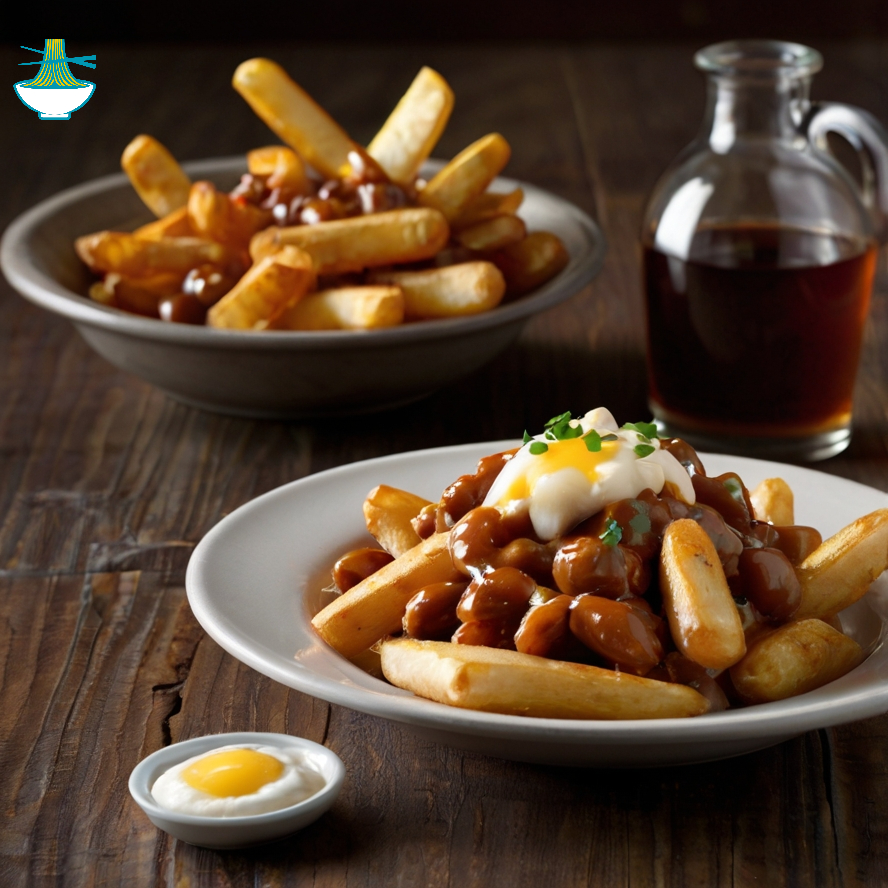Poutine is a beloved Canadian dish originating from Quebec in the late 1950s. This indulgent comfort food consists of crispy french fries, cheese curds, and hot gravy. Despite its humble beginnings, poutine has gained international fame for its rich and satisfying flavors. The dish's versatility allows for various toppings and adaptations, making it a favorite among many.

Poutine's origins trace back to rural Quebec in the late 1950s. The exact birthplace and creator of poutine are subjects of friendly debate, but it's widely accepted that the dish emerged from combining french fries, cheese curds, and gravy. Initially considered a working-class meal, poutine quickly gained popularity and spread throughout Canada. Today, it is a national culinary icon, with numerous regional and gourmet variations.
Ingredients:
- 3 large russet potatoes, peeled and cut into 1/4 inch thick fries
- 2 cups cheese curds
- 2 cups beef or chicken gravy
- 2 tablespoons vegetable oil
- Salt and black pepper to taste
Method:
1. Preheat the oven to 400°F. Line a baking sheet with parchment paper and set aside.
2. Rinse the cut potatoes under cold water to remove excess starch. Dry thoroughly with a clean kitchen towel.
3. In a large mixing bowl, toss the potatoes with vegetable oil, salt, and black pepper until evenly coated.
4. Arrange the potatoes in a single layer on the prepared baking sheet. Bake for 25-30 minutes, flipping halfway through, until golden brown and crispy.
5. While the fries are baking, heat the gravy in a small saucepan over medium-low heat. Keep warm until ready to serve.
6. Once the fries are done, remove them from the oven and transfer to a large serving platter. Sprinkle cheese curds over the hot fries.
7. Pour warm gravy over the cheese curds and fries, covering everything evenly.
8. Serve immediately, garnished with chopped fresh parsley if desired.
Notes:
1. Cheese curds are small, chunky pieces of cheese with a slightly tangy and salty taste. They can be found in most grocery stores or specialty food shops.
2. Poutine can be customized with different types of gravy, such as mushroom or turkey, and toppings like bacon, pulled pork, or green onions.
3. To make vegetarian poutine, substitute the beef or chicken gravy with a vegetable-based gravy.

Nutrition Facts (per serving):
- Calories: 450
- Protein: 15g
- Carbohydrates: 60g
- Fat: 18g
- Saturated Fat: 8g
- Fiber: 5g
- Sugar: 2g
- Sodium: 800mg
1. 3 Large Russet Potatoes (Peeled and Cut into 1/4 inch Thick Fries)
Nutritional Information (per large potato)
- Calories: 290
- Carbohydrates: 66g
- Protein: 7g
- Fat: 0.3g
- Sodium: 22mg
- Cholesterol: 0mg
- Vitamins: Vitamin C (70% DV), Vitamin B6 (35% DV)
- Minerals: Potassium (1600mg), Iron (10% DV), Magnesium (15% DV)
Nutritional Benefits:
- Carbohydrates: Provide energy.
- Vitamin C: Important for immune function and skin health.
- Vitamin B6: Supports brain health and energy metabolism.
- Potassium: Essential for heart health and muscle function.
2. 2 Cups Cheese Curds
Nutritional Information (per cup)
- Calories: 400
- Carbohydrates: 2g
- Protein: 28g
- Fat: 33g
- Sodium: 640mg
- Cholesterol: 105mg
- Vitamins: Vitamin A (20% DV), Vitamin B12 (25% DV)
- Minerals: Calcium (60% DV), Phosphorus (45% DV)
Nutritional Benefits:
- Protein: Builds and repairs tissues.
- Calcium: Essential for bone health.
- Vitamin A: Supports vision and immune function.
- Vitamin B12: Necessary for red blood cell formation and neurological function.
3. 2 Cups Beef or Chicken Gravy
Nutritional Information (per cup, average)
- Calories: 100
- Carbohydrates: 8g
- Protein: 4g
- Fat: 6g
- Sodium: 800mg
- Cholesterol: 20mg
- Vitamins: Varies
- Minerals: Iron (8% DV)
Nutritional Benefits:
- Protein: Supports muscle maintenance.
- Iron: Essential for blood oxygenation.
- Fat: Provides energy and aids in vitamin absorption.
4. 2 Tablespoons Vegetable Oil
Nutritional Information (per tablespoon)
- Calories: 120
- Carbohydrates: 0g
- Protein: 0g
- Fat: 14g
- Sodium: 0mg
- Cholesterol: 0mg
- Vitamins: Vitamin E (10% DV)
- Minerals: None
Nutritional Benefits:
- Fat: Provides energy and supports cell function.
- Vitamin E: Acts as an antioxidant, protecting cells from damage.
5. Salt and Black Pepper to Taste
Nutritional Information (per teaspoon of salt)
- Calories: 0
- Carbohydrates: 0g
- Protein: 0g
- Fat: 0g
- Sodium: 2325mg
- Cholesterol: 0mg
- Vitamins: None
- Minerals: None
Nutritional Information (per teaspoon of black pepper)
- Calories: 6
- Carbohydrates: 1.4g
- Protein: 0.2g
- Fat: 0.1g
- Sodium: 1mg
- Cholesterol: 0mg
- Vitamins: Vitamin K (6% DV)
- Minerals: Manganese (13% DV)
Nutritional Benefits:
- Salt: Enhances flavor but should be used in moderation due to high sodium content.
- Black Pepper: Contains antioxidants and anti-inflammatory properties.
Total Nutritional Summary (Approximate per serving of the entire recipe)
Calories: 1328
Carbohydrates: 150g
Protein: 74g
Fat: 100g
Sodium: 4849mg
Cholesterol: 250mg
Key Vitamins and Minerals:
- Vitamin C: 140% DV
- Vitamin B6: 70% DV
- Vitamin A: 40% DV
- Vitamin B12: 50% DV
- Vitamin E: 20% DV
- Vitamin K: 6% DV
- Calcium: 120% DV
- Potassium: 3200mg
- Iron: 18% DV
- Magnesium: 30% DV
- Phosphorus: 90% DV
- Manganese: 13% DV
Overall Nutritional Benefits:
- Provides a substantial amount of energy through carbohydrates and fats.
- High in protein, supporting muscle repair and maintenance.
- Rich in calcium and potassium, essential for bone and heart health.
- Contains significant amounts of vitamins and minerals that support various bodily functions.
Remember, the nutritional values can vary based on specific brands and preparation methods.


Comments